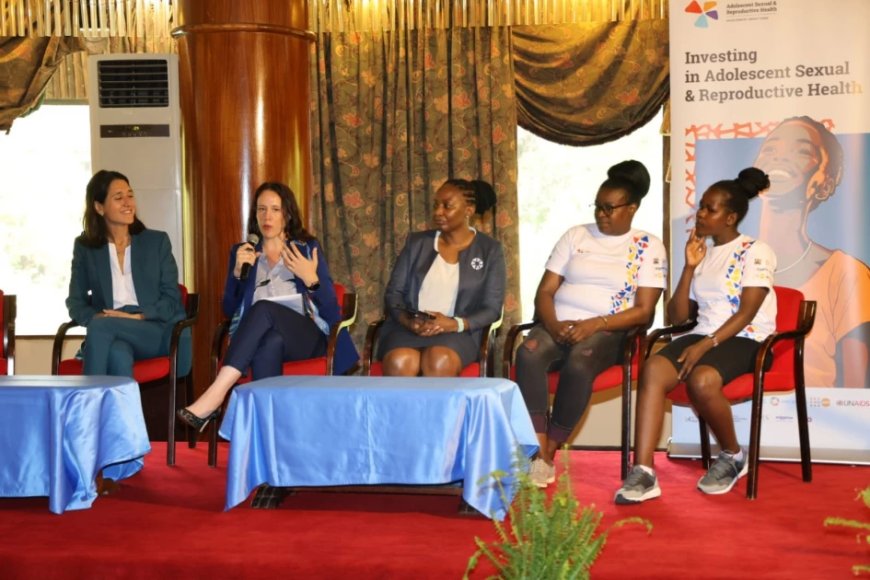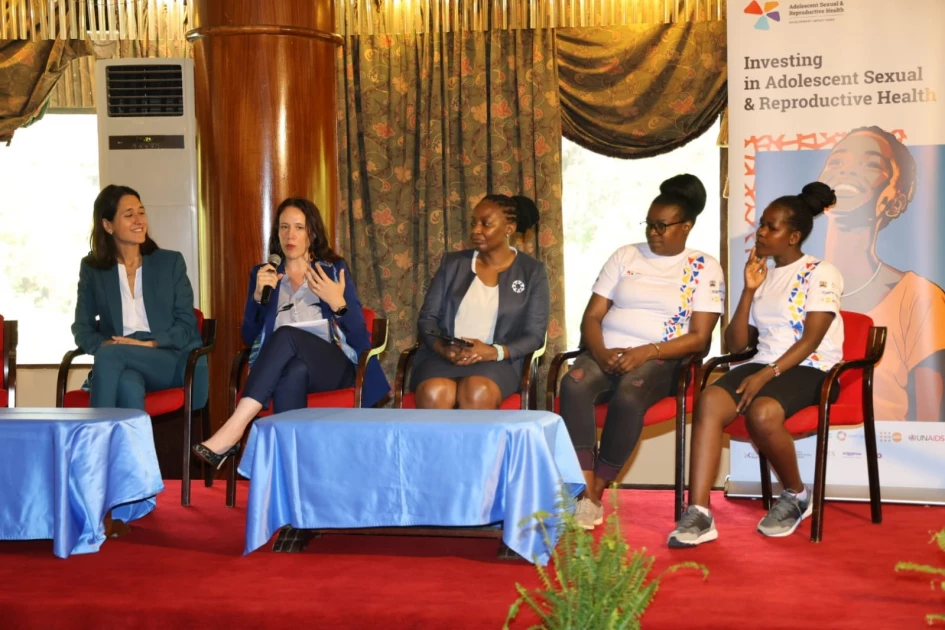Development Impact Bond for adolescent sexual and reproductive health rolled out in Kenya
Development Impact Bond for adolescent sexual and reproductive ... Citizen Digital

The United Nations Launches Development Impact Bond to Address Teenage Pregnancy and HIV Infections in Kenya

Introduction
The United Nations (UN) in Kenya, in collaboration with various organizations including the United Nations Population Fund (UNFPA), the Joint United Nations Program on HIV/AIDS (UNAIDS), the World Health Organization (WHO), and the Sustainable Development Goals (SDG) Partnership Platform, has announced the launch of a Development Impact Bond (DIB). This initiative aims to address the challenges of teenage pregnancy and new HIV infections among adolescents in Kenya.
Objectives
The Development Impact Bond will fund the delivery of high-quality, adolescent and youth-friendly sexual and reproductive health services, including HIV testing and treatment, to adolescent girls aged 15-19. The goal is to provide comprehensive support and care to vulnerable adolescent girls in Kenya, focusing on issues such as the lack of information about sexual and reproductive health and rights, as well as inadequate access to tailored services for young people.
Adolescent Health Crisis in Kenya
According to the 2023 National HIV Estimates, Kenya is currently facing a significant adolescent health crisis. In 2022, there were 7,307 new HIV infections recorded among adolescents and young people aged 15-24, accounting for 41% of all new HIV infections in the country.
Partnerships and Funding
The Development Impact Bond is backed by $10.1 million (approximately Ksh.1.49 billion) in funding provided by the Joint SDG Fund and the Children’s Investment Fund Foundation (CIFF). Bridges Outcomes Partnerships will provide upfront funding to Triggerise, a global non-profit organization (NGO), through a two-year pay-for-success program. The objective is to support sexual and reproductive health and HIV services to over 300,000 adolescent girls.
Mobile-Based Digital Landscape
The Development Impact Bond will leverage Triggerise’s Tiko platform, a mobile-based digital landscape designed to connect adolescents with health clinics, pharmacies, community-based organizations, and health workers. This innovative approach aims to improve access to essential services and empower adolescent girls to take control of their own health.
Government Support
Dr. Bashir Issak, Head of the Directorate of Family Health at the Ministry of Health, expressed support for the program, stating that it aligns with the government’s efforts to address the challenges of teenage pregnancy, adolescent HIV, and gender-based violence (GBV).
Importance of Sexual and Reproductive Health Services
Dr. Stephen Jackson, United Nations (UN) Resident Coordinator, emphasized the importance of providing accurate information and top-tier sexual and reproductive health services to adolescents in low-income settings. He highlighted that privacy concerns and service provider bias often discourage adolescents from seeking help, underscoring the urgent need to support adolescents in relation to their sexual and reproductive health and rights.
Implementation
The program will be implemented in counties that bear a significant burden of HIV and adolescent pregnancy, including Nairobi, Mombasa, Kisumu, Homa Bay, Bungoma, Migori, Kisii, Nyamira, Kakamega, and Busia.
SDGs, Targets, and Indicators Analysis
1. Which SDGs are addressed or connected to the issues highlighted in the article?
- SDG 3: Good Health and Well-being
- SDG 5: Gender Equality
- SDG 10: Reduced Inequalities
- SDG 17: Partnerships for the Goals
The article discusses the launch of a Development Impact Bond (DIB) aimed at addressing the challenges of teenage pregnancy and new HIV infections among adolescents in Kenya. These issues are directly connected to SDG 3, which focuses on ensuring healthy lives and promoting well-being for all at all ages. Additionally, the article mentions the lack of information about sexual and reproductive health and rights and inadequate access to services tailored to young people, highlighting the need for gender equality (SDG 5) and reduced inequalities (SDG 10). The partnership between various organizations and the government also aligns with SDG 17, which emphasizes the importance of partnerships for achieving sustainable development.
2. What specific targets under those SDGs can be identified based on the article’s content?
- Target 3.3: By 2030, end the epidemics of AIDS, tuberculosis, malaria, and neglected tropical diseases and combat hepatitis, water-borne diseases, and other communicable diseases.
- Target 5.6: Ensure universal access to sexual and reproductive health and reproductive rights as agreed in accordance with the Program of Action of the International Conference on Population and Development and the Beijing Platform for Action and the outcome documents of their review conferences.
- Target 10.3: Ensure equal opportunity and reduce inequalities of outcome, including by eliminating discriminatory laws, policies, and practices and promoting appropriate legislation, policies, and action in this regard.
- Target 17.16: Enhance the global partnership for sustainable development, complemented by multi-stakeholder partnerships that mobilize and share knowledge, expertise, technology, and financial resources to support the achievement of the sustainable development goals in all countries, in particular developing countries.
Based on the issues highlighted in the article, the specific targets under the relevant SDGs can be identified. Target 3.3 focuses on ending the epidemics of AIDS and combatting other communicable diseases, which directly relates to addressing new HIV infections among adolescents. Target 5.6 emphasizes ensuring universal access to sexual and reproductive health and reproductive rights, which aligns with the goal of providing high-quality sexual and reproductive health services to adolescent girls. Target 10.3 aims to reduce inequalities of outcome, including eliminating discriminatory practices, which is relevant to addressing the challenges faced by vulnerable adolescent girls. Target 17.16 highlights the importance of partnerships for achieving sustainable development, which is reflected in the collaboration between various organizations and the government in launching the Development Impact Bond.
3. Are there any indicators mentioned or implied in the article that can be used to measure progress towards the identified targets?
- Number of new HIV infections among adolescents and young people aged 15-24
- Number of adolescent girls accessing sexual and reproductive health services
- Percentage of adolescents with access to accurate information about sexual and reproductive health and rights
- Number of adolescent girls benefiting from the Development Impact Bond program
The article mentions the number of new HIV infections recorded among adolescents and young people aged 15-24 in Kenya, which can be used as an indicator to measure progress towards Target 3.3. The article also highlights the objective of supporting sexual and reproductive health and HIV services to over 300,000 adolescent girls through the Development Impact Bond program, indicating a potential indicator for measuring progress. Additionally, the lack of information about sexual and reproductive health and rights is mentioned, suggesting that the percentage of adolescents with access to accurate information can be used as an indicator. The number of adolescent girls benefiting from the program can also serve as an indicator to measure progress towards the identified targets.
4. Table: SDGs, Targets, and Indicators
| SDGs | Targets | Indicators |
|---|---|---|
| SDG 3: Good Health and Well-being | Target 3.3: By 2030, end the epidemics of AIDS, tuberculosis, malaria, and neglected tropical diseases and combat hepatitis, water-borne diseases, and other communicable diseases. | Number of new HIV infections among adolescents and young people aged 15-24 |
| SDG 5: Gender Equality | Target 5.6: Ensure universal access to sexual and reproductive health and reproductive rights as agreed in accordance with the Program of Action of the International Conference on Population and Development and the Beijing Platform for Action and the outcome documents of their review conferences. | Number of adolescent girls accessing sexual and reproductive health services |
| Target 10.3: Ensure equal opportunity and reduce inequalities of outcome, including by eliminating discriminatory laws, policies, and practices and promoting appropriate legislation, policies, and action in this regard. | Number of adolescent girls benefiting from the Development Impact Bond program | |
| SDG 17: Partnerships for the Goals | Target 17.16: Enhance the global partnership for sustainable development, complemented by multi-stakeholder partnerships that mobilize and share knowledge, expertise, technology, and financial resources to support the achievement of the sustainable development goals in all countries, in particular developing countries. | N/A |
Behold! This splendid article springs forth from the wellspring of knowledge, shaped by a wondrous proprietary AI technology that delved into a vast ocean of data, illuminating the path towards the Sustainable Development Goals. Remember that all rights are reserved by SDG Investors LLC, empowering us to champion progress together.
Source: citizen.digital

Join us, as fellow seekers of change, on a transformative journey at https://sdgtalks.ai/welcome, where you can become a member and actively contribute to shaping a brighter future.







